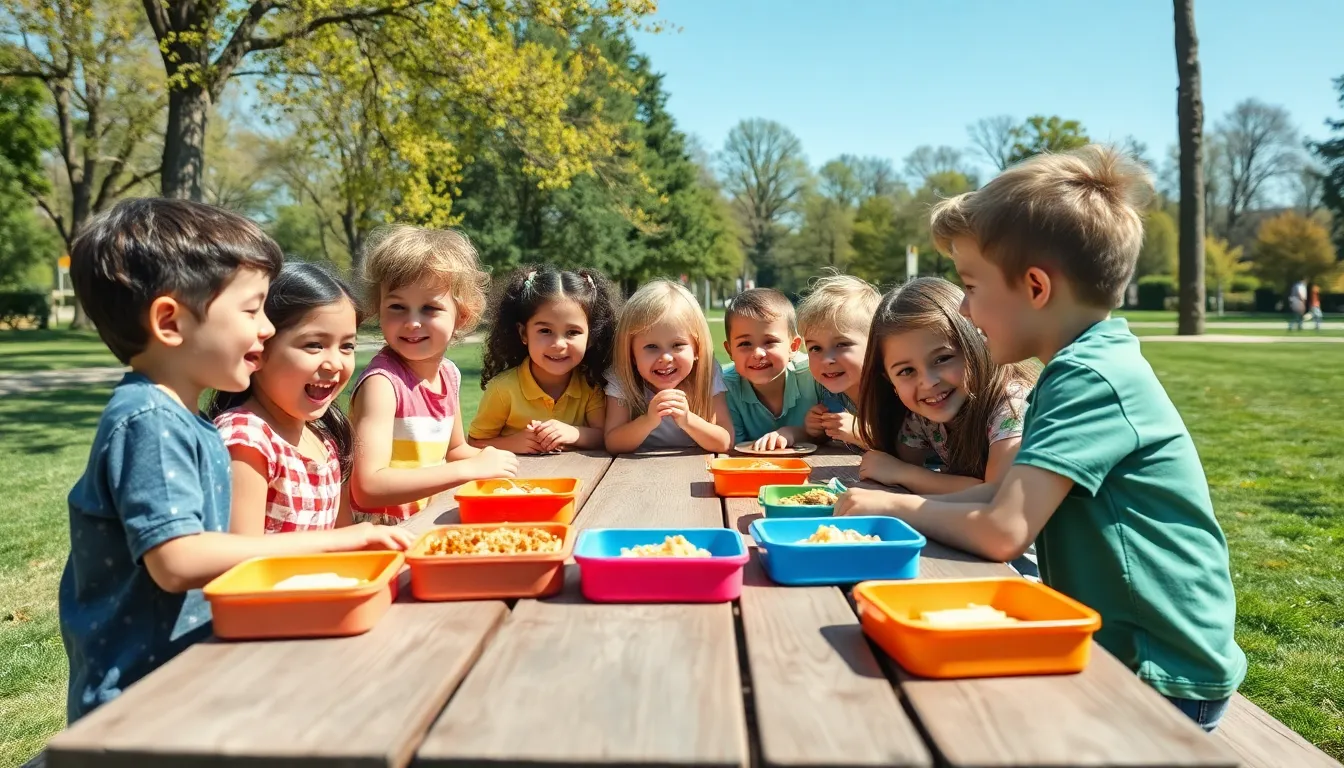Table of Contents
ToggleLunchtime with kids can feel like a circus act—clowns juggling food, acrobats dodging broccoli, and the occasional lion tamer trying to keep the chaos in check. But what if that delightful mayhem could transform into a source of joy and connection? Lunchtime laughter isn’t just about silly jokes or funny faces; it’s a golden opportunity to bond, spark creativity, and make memories that last a lifetime.
The Importance of Lunchtime Laughter With Kids
Lunchtime laughter plays a crucial role in child development. When kids share humor during meals, they strengthen emotional bonds.
Positive interactions at the table foster communication skills. Engaging in playful conversations encourages creativity. Children express themselves more freely in a light-hearted environment.
Studies show laughter reduces stress levels. Lower stress improves digestion, making meals more enjoyable. Kids thrive in settings where they feel relaxed and happy.
This joyful atmosphere allows parents to model social skills. Demonstrating laughter and playfulness teaches kids how to connect with others. Learning through laughter enhances problem-solving abilities, too.
Memorable moments created at lunchtime build resilience. Kids who experience joy during meals develop better coping mechanisms. They learn to navigate challenges with a positive outlook.
Creating a space for humor encourages collaborative play. Kids share jokes, stories, and funny experiences, reinforcing teamwork. Such interactions cultivate empathy and understanding among peers.
Importantly, laughter aids in cognitive development. When children laugh together, they activate brain areas associated with learning. It’s a simple yet effective way to boost knowledge retention.
Overall, lunchtime laughter contributes to a well-rounded upbringing. Fun moments during meals create deeper connections. Parents and kids who share laughter often enjoy healthier relationships.
Benefits of Laughter for Children

Laughter provides numerous benefits for children, enhancing various aspects of their lives.
Emotional Well-Being
Childhood can be filled with stressors. Laughter acts as a natural stress reliever, promoting a sense of comfort. When kids laugh, it triggers the release of endorphins, fostering an overall sense of happiness. Positive emotions flourish in playful environments during lunchtime. Developing coping mechanisms becomes easier as children engage in humor. They learn to face challenges with a lighter heart. By sharing laughs, kids bond with family members, creating a safe space for emotional expression. This relaxed atmosphere encourages children to articulate feelings, ultimately leading to improved emotional intelligence.
Building Social Connections
Social interactions thrive on shared experiences. Laughter strengthens social skills and encourages connections among children. During lunchtime, humor breaks down barriers, fostering peer relationships. Kids who share jokes often demonstrate increased empathy and understanding towards others. This camaraderie teaches them the value of teamwork, as playful exchanges enhance collaboration. Engaging in humorous conversations builds confidence, making children feel more at ease in social settings. Through laughter, children gain communication skills essential for forming friendships, leading to healthier social dynamics over time.
Creative Ways to Encourage Laughter at Lunch
Creating laughter at lunchtime enhances emotional bonds and promotes joyful experiences. Various engaging ideas can elevate the mealtime atmosphere.
Fun Lunchbox Notes
Including whimsical notes in lunchboxes sparks smiles and prompts joyful conversations. Kids appreciate finding silly jokes, riddles, or even motivational quotes. Simple notes expressing love or inside jokes create memorable connections. Individualized messages can help children feel valued and foster a sense of belonging. Parents can rotate themes each week, such as animal facts or character quotes, making lunchtime a delightful surprise.
Silly Food Presentations
Arranging food in playful, imaginative ways encourages laughter and creativity. Use cookie cutters to shape sandwiches into fun designs or create animal faces with fruits and vegetables. Colorful arrangements of food can also ignite curiosity and laughter. Try serving “rainbow” wraps or “monster” snacks with googly eyes made from olives or cheese. Unique food presentations make meals visually appealing and inspire children to engage in playful eating.
Incorporating Humor into Lunchtime Routine
Creating a lively lunchtime environment sparks joy and strengthens family bonds. Engaging kids in humor promotes connection and creativity.
Storytelling and Jokes
Storytelling engages children, igniting their imagination while adding laughter to meals. Families can take turns sharing funny, relatable tales. Jokes also lighten moods, encouraging giggles and playful banter. Parents should keep jokes simple, ensuring everyone understands and participates. A few silly puns or riddles during lunch can lead to memorable moments and shared laughter. By creating a space for humor, parents contribute to children’s emotional growth. As children share their own stories and jokes, they enhance communication skills and creativity.
Games and Interactive Activities
Incorporating games makes lunchtime enjoyable and promotes laughter. Simple games like “I Spy” can spark excitement during meals. Kids often thrive on friendly competition, so using food as a theme for games can elevate engagement. Families could play a “Guess the Food” game to encourage interaction and curiosity. Interactive food presentations add a playful element; for instance, creating funny shapes with fruits and veggies engages children visually and imaginatively. These activities not only uplift the atmosphere but also build teamwork and empathy, nurturing healthy relationships during mealtime.
Lunchtime with kids is more than just a meal; it’s an opportunity for laughter and connection. By embracing humor during this time, families can strengthen their bonds and create a nurturing environment. The playful exchanges not only enhance emotional well-being but also promote essential communication skills and creativity.
Incorporating laughter into lunchtime routines cultivates resilience and empathy among children, equipping them with valuable social tools. With simple additions like whimsical notes or interactive games, parents can transform mealtime into a joyful experience that fosters lasting memories. Ultimately, these moments of laughter contribute to a child’s overall development and pave the way for healthier relationships both at home and beyond.






